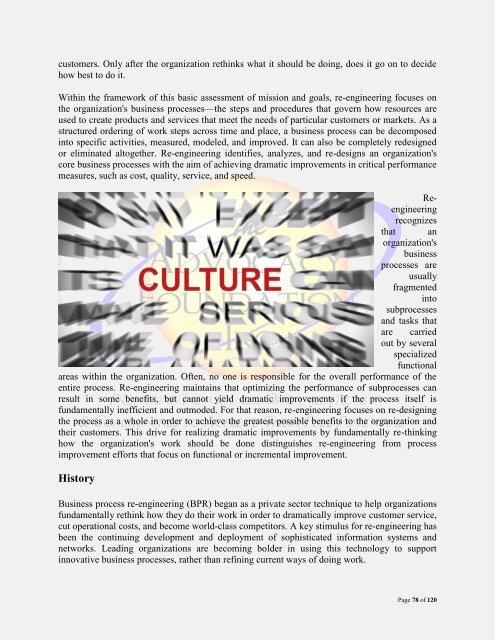Organizational Development - Vol. V, Part II
Organizational Development - Vol. V, Part II
Organizational Development - Vol. V, Part II
Create successful ePaper yourself
Turn your PDF publications into a flip-book with our unique Google optimized e-Paper software.
customers. Only after the organization rethinks what it should be doing, does it go on to decide<br />
how best to do it.<br />
Within the framework of this basic assessment of mission and goals, re-engineering focuses on<br />
the organization's business processes—the steps and procedures that govern how resources are<br />
used to create products and services that meet the needs of particular customers or markets. As a<br />
structured ordering of work steps across time and place, a business process can be decomposed<br />
into specific activities, measured, modeled, and improved. It can also be completely redesigned<br />
or eliminated altogether. Re-engineering identifies, analyzes, and re-designs an organization's<br />
core business processes with the aim of achieving dramatic improvements in critical performance<br />
measures, such as cost, quality, service, and speed.<br />
Reengineering<br />
recognizes<br />
that an<br />
organization's<br />
business<br />
processes are<br />
usually<br />
fragmented<br />
into<br />
subprocesses<br />
and tasks that<br />
are carried<br />
out by several<br />
specialized<br />
functional<br />
areas within the organization. Often, no one is responsible for the overall performance of the<br />
entire process. Re-engineering maintains that optimizing the performance of subprocesses can<br />
result in some benefits, but cannot yield dramatic improvements if the process itself is<br />
fundamentally inefficient and outmoded. For that reason, re-engineering focuses on re-designing<br />
the process as a whole in order to achieve the greatest possible benefits to the organization and<br />
their customers. This drive for realizing dramatic improvements by fundamentally re-thinking<br />
how the organization's work should be done distinguishes re-engineering from process<br />
improvement efforts that focus on functional or incremental improvement.<br />
History<br />
Business process re-engineering (BPR) began as a private sector technique to help organizations<br />
fundamentally rethink how they do their work in order to dramatically improve customer service,<br />
cut operational costs, and become world-class competitors. A key stimulus for re-engineering has<br />
been the continuing development and deployment of sophisticated information systems and<br />
networks. Leading organizations are becoming bolder in using this technology to support<br />
innovative business processes, rather than refining current ways of doing work.<br />
Page 78 of 120

















